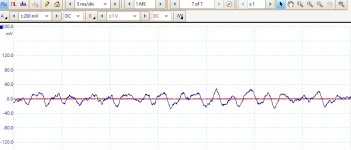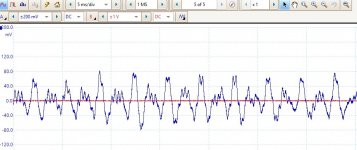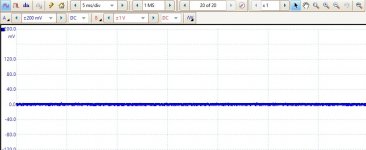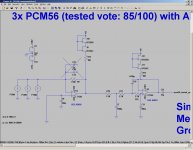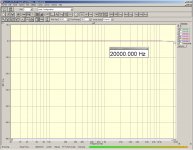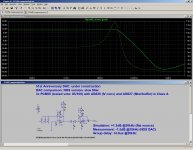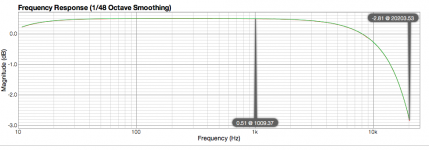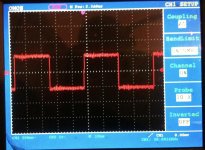My idea is to form each sample as a very short "spike" of converted amplitude, and zero between the spikes. A conventional analog filter should follow.
The 'spike' would need to be a 'delta function' which isn't practical in real-world electronics because you can't get a high enough supply voltage.
You can approximate a 'spike' by going to (say) 16X oversampling and setting 15 out of the 16 output samples to zero. The 16th one is a copy of the input sample. You'll then find the output amplitude has been attenuated by a factor of 16, but at least the FR will be essentially flat in the audio band.
SAMPLE RATE EXPERIMENTS
I have a SRC4192 EV, a sample rate converter board which is a very useful tool, if expensive.
The input is via spdif, I2S, 44K FS, 2.822Mhz BCK.
I can change the SRC's master clock which changes the output FS, BCK & MCLK:
FS BCK MCK
64 4.1 8.2
88 5.7 11.7
96 6.1 12.3
128 8.2 16.4
176 11.3 22.6
192 12.3 24.6
I captured some scope traces at the output of my I/V transformer and listened to the same track.
I found little difference in the SQ which is I assume is mainly down to the dacs (NOS AD1862) & transformer I/V) but I did find myself preferring the lower FS settings.
I had expected to find the higher FS settings to be better as the transformer will be more effective a filter.
There is no other filtering other than that provided by the transformer. There is more noise visible on the 192K mode but its possible its the AD1862 and this was also least preferred setting.
Traces: 64k, 88k, 96, 176k, 192k, 88k no signal, 192k no signal
I have a SRC4192 EV, a sample rate converter board which is a very useful tool, if expensive.
The input is via spdif, I2S, 44K FS, 2.822Mhz BCK.
I can change the SRC's master clock which changes the output FS, BCK & MCLK:
FS BCK MCK
64 4.1 8.2
88 5.7 11.7
96 6.1 12.3
128 8.2 16.4
176 11.3 22.6
192 12.3 24.6
I captured some scope traces at the output of my I/V transformer and listened to the same track.
I found little difference in the SQ which is I assume is mainly down to the dacs (NOS AD1862) & transformer I/V) but I did find myself preferring the lower FS settings.
I had expected to find the higher FS settings to be better as the transformer will be more effective a filter.
There is no other filtering other than that provided by the transformer. There is more noise visible on the 192K mode but its possible its the AD1862 and this was also least preferred setting.
Traces: 64k, 88k, 96, 176k, 192k, 88k no signal, 192k no signal
Attachments
Last edited:
That is what they often say, but how does anyone know if it is true? You would need to compare a filterless NOS DAC with a filtered NOS DAC, under double-blind conditions.MagicBus said:I always thought that the NOS fans accepted the HF roll off and images as a necessary compromise in order to avoid the phase shift problems associated with the digital -and analog- filters.
Oversampling is itself a form of digital filter.This is the origin of my question: can oversampling be done separately from filtering, has anybody done this or it wouldn't work? Is the oversampling itself that could introduce phase problems?
No DAC produces aliases. A DAC with differential-mode output produces images in differential-mode; it may or may not also produce other stuff in common-mode, but all common-mode can be thrown away - that is the point of a differential output.Do we know what part of the DAC's noise -reconstruction images, aliasing etc- is common mode and what is differential?
Lots of people don't like flat frequency response; many of them do not realise, so have to find other 'reasons' for their preferences.But that would mean that NOS fans simply don't like flat frequency response and linear phase.
I suspect that NOS fans like the HF rolloff, and the presence of the first image will give some HF tizz which might brighten percussion - although only younger NOS fans will actually be able to hear this.
Quoted by TNT:
Why do people write this sort of rubbish?
Untrue. A sine wave under the Nyquist limit is fully described by the samples. No loss of information, so no loss of amplitude. The HF dip seen on the DAC output is not caused by sampling, but by the zero-order-hold output."Something else to notice is that as the frequency increases, with fewer samples to define the sinusoidal wave (since we only have 44.1kHz sample points), notice that many of the frequency peaks do not reach the full amplitude of the sine wave with the NOS output. This correlates with the dip in high frequency amplitude response which we can easily measure:..."
Why do people write this sort of rubbish?
In many cases the new 'samples' are simply zeroes; no approximation or interpolation is used. Then the oversampled data is fed into a digital reconstruction filter.lcsaszar said:Oversampling is stuffing new samples between real (repeating at 44.1 kHz or 48 kHz rate) samples. If the new samples in between are identical to the previous real sample, that has nil effect. The goal usually is to "guess" the original analog value at the new samples. It can be done by linear approximation or higher order function, that is using some kind of digital filter. A digital filter can be created to be linear phase.
Yes, this sort of output would result in less HF rolloff. Get an infinitely narrow spike and you would have no rolloff at all.I have been thinking about a different kind of NOS DAC for a while:
It does not need to be zero-order sample-and-hold, i.e. staircase analog output. My idea is to form each sample as a very short "spike" of converted amplitude, and zero between the spikes. A conventional analog filter should follow.
DF96 - your first quote was real measurement - reality is different form theory. But I agree - it is for sure not due to "less samples per period".
//
//
I have been thinking about a different kind of NOS DAC for a while:
It does not need to be zero-order sample-and-hold, i.e. staircase analog output. My idea is to form each sample as a very short "spike" of converted amplitude, and zero between the spikes. A conventional analog filter should follow.
Is there any mathematically talented among us who can perform the Fourier trasform and provide the resulting spectrum?
As it turns out, Italian audio website, TNT, some years ago published an DIY NOS DAC project which explores a practical implementation of that idea a bit. It's in three parts, plus a follow-up fourth part. Links follow below.
Convertus Decima [English]
Fourth part:
Concertus Decima Digital [English]
Last edited:
I have been thinking about a different kind of NOS DAC for a while:
It does not need to be zero-order sample-and-hold, i.e. staircase analog output. My idea is to form each sample as a very short "spike" of converted amplitude, and zero between the spikes. A conventional analog filter should follow.
Is there any mathematically talented among us who can perform the Fourier trasform and provide the resulting spectrum?
"Short spikes" (in perfection "dirac impulses" ) is exactly what SWK had in mind when formulating the sampling theorem.
The repetition of the audio band content around multiples of the sampling frequency (the so-called images) are the consequence of the sampling process itself and need to be filtered out by a so-called reconstruction filter.
To which degree is a good question, as there exist different hypothesises about the perceptual impact this higher frequency content might have.
From a technical viewpoint it should be good to attenuate the images to a level where prefereable no perceptable IMD (in electronics or speakers) would be generated.
Afair the people at Pioneer in the ~90s thought it would be better to have some content in the above 20 kHz region even if it couldn´t be the correct one (the so-called legato link process), so it could be that an attenuation of around 30-40 dB is already sufficient or even beneficiary.
Lots of people don't like flat frequency response; many of them do not realise, so have to find other 'reasons' for their preferences.
I suspect that NOS fans like the HF rolloff, .....
After many listening tests I believe now to prefer a slow filter too with NOS PCM56. Thus, as Mr. Shu-Nkmr Sakura experimented Audio DA Converter SN-DAC0503, I will give up of one order filter, gaining +1.5 dB at 20kHz but maintaining a small group delay (<5us). But I had to play also with op-amp rolling to get sweet highs and large but very focused soundstage (hence AD826 and AD827).
I think that I'm more sensitive to phase distortion for long group delay, than to flat frequency response: I happy with a slow HF roll-off as this is actually giving me the lower listening fatigue and the best soundstage.
Attachments
After many listening tests I believe now to prefer a slow filter too with NOS PCM56. Thus, as Mr. Shu-Nkmr Sakura experimented Audio DA Converter SN-DAC0503, I will give up of one order filter, gaining +1.5 dB at 20kHz but maintaining a small group delay (<5us). But I had to play also with op-amp rolling to get sweet highs and large but very focused soundstage (hence AD826 and AD827).
I think that I'm more sensitive to phase distortion for long group delay, than to flat frequency response: I happy with a slow HF roll-off as this is actually giving me the lower listening fatigue and the best soundstage.
I think you have found out what many of us listening to NOS dacs already know - slow roll off is preferred or you might as well stick with OS.
This is not surprising because the CD player manufacturers spend millions trying to produce the perfect filter for use with DACs before oversampling was introduced and made life much easier & simpler for them.
There is also of course, additional filtering in the amplifier and the speakers which contribute to the SQ.
Cirrus has implemented NOS in a delta sigma dac CS43130. I am not sure how that's differ to the multibit dac and I am not tech savvy enough to interpret the charts in the datasheet.
https://statics.cirrus.com/pubs/proDatasheet/CS43130_F1.pdf
https://statics.cirrus.com/pubs/proDatasheet/CS43130_F1.pdf
We had a long discussion about that in another DAC thread. Presumably they replace the digital filter with a zeroth-order hold, but the sigma-delta modulator itself still oversamples (runs at a much higher bit rate than the input word rate), because it can't possibly work otherwise. Whether this makes sense depends on what you want to achieve; if you like slight treble roll-off or if you worry about possible deficiencies of the digital interpolation filter, this may be as good as a real non-oversampling DAC.
I could not agree more with Ken Newton about the influence of some kind of noise into the center of the BW. Maybe more deep than 5KHz? I found some differences regarding of listening files, and origin of the listening matherial... Try to compare 1. film music 2. original issue 3. internet downloaded flac files.
...
I didnt try only passive multi tap notch filter Zanden style (preparing to build and try) to somehow deal with digital.
.
And more, I spot almost on ewery FFT measurement I did tht: All maximum peak points formed line about +6db from 1-2KHz to upper border. That is for each chnnel. But we have 2 times the same thing?
So, I think that some 4 octave from 20KHz (1.25KHz) should start some multiple RL filter with 1.5db/ost. to flatten all of that range and let the peaks to be in flat line. After that aplying filtering to cut off.
..
I did something in Spice it is similar with bafle step recponse filter for loudspeakers, but have 4 sections of parallel RL nets, serialy cinected. I will try to find this
...
I didnt try only passive multi tap notch filter Zanden style (preparing to build and try) to somehow deal with digital.
.
And more, I spot almost on ewery FFT measurement I did tht: All maximum peak points formed line about +6db from 1-2KHz to upper border. That is for each chnnel. But we have 2 times the same thing?
So, I think that some 4 octave from 20KHz (1.25KHz) should start some multiple RL filter with 1.5db/ost. to flatten all of that range and let the peaks to be in flat line. After that aplying filtering to cut off.
..
I did something in Spice it is similar with bafle step recponse filter for loudspeakers, but have 4 sections of parallel RL nets, serialy cinected. I will try to find this
Last edited:
I made some amateur measurements on my hand made discrete dac. "Big" ICs, 5V simple regulator supply per channel, point to point no PCBs, I2S input isolatied constant BCK clocking, 32bit word and latch, 1%R2R tol net, only MSB trimmed, no fancy stuff - worst case scenario...
It is acting like Nyquist/Shannon predict in NOS mode.
But it sounds much better than contemporary things and without any filtering (only interstage to transform from BAL-to-SE, (acting like HF filter @ some point...).
And FFT showing only about +2.5db maximum points from the mid to top end. FFT taken in OS mode i cant remember 192KHz or 352KHz sorry...
It is acting like Nyquist/Shannon predict in NOS mode.
But it sounds much better than contemporary things and without any filtering (only interstage to transform from BAL-to-SE, (acting like HF filter @ some point...).
And FFT showing only about +2.5db maximum points from the mid to top end. FFT taken in OS mode i cant remember 192KHz or 352KHz sorry...
Attachments
Last edited:
Sorry for wasting 3rd post, but somehow, that thing Ken Newton talking about, depends of input format too? I spot with Simultaneous format with TDA1540 and TDA1541A build and listening, significantly less, I dont know how to say, this "intrusion" from HF to mid-band?
And BTW it is hard to believe but TDA1540 14bit shoving almost perfect square converted at output from 20KHz computer generated digital signal (ElectroAcousticToolBox software free edition)...
And BTW it is hard to believe but TDA1540 14bit shoving almost perfect square converted at output from 20KHz computer generated digital signal (ElectroAcousticToolBox software free edition)...
Attachments
Sorry for wasting 3rd post, but somehow, that thing Ken Newton talking about, depends of input format too? I spot with Simultaneous format with TDA1540 and TDA1541A build and listening, significantly less, I dont know how to say, this "intrusion" from HF to mid-band?
And BTW it is hard to believe but TDA1540 14bit shoving almost perfect square converted at output from 20KHz computer generated digital signal (ElectroAcousticToolBox software free edition)...
You mean you don't hear any aliasing and other artefacts.
I use IanCanada's boards, and my dual nos 1541 board, working in simultaneous, mode, with stopped clock and with one dac (+&- data) per channel, 100R I/V with balanced transformer output, no preamp or filters and hear nothing unwanted. (though my hearing doesn't extend much above 12kHz).
I certainly would never be able to hear a couple of db roll off at 20Khz - who would?
Stopping bck, using dual balanced dacs and balanced transformers makes a big difference in nos mode. (common mode noise cancels out so any filtering requirement is less onerous)
Hi Batteryman. But You have FiFo before I2S/Sim.?
Did You find diff. I2S vs Time Simultaneous format sonicaly?
Not only stopped clock but L and R data lines converts in the same time / I2S BCK running all of the time, and dac hold L data until R data comes then go to converskon?
...
I am a bit older, probably I can not hear much of the upper band too 🙁 but I can hear this what Ken is talking. Now You confirm from direct experience something close to that I spot.
...
Yes I foun this just like You said
"Stopping bck, using dual balanced dacs and balanced transformers makes a big difference in nos mode. (common mode noise cancels out so any filtering requirement is less onerous)"
Did You find diff. I2S vs Time Simultaneous format sonicaly?
Not only stopped clock but L and R data lines converts in the same time / I2S BCK running all of the time, and dac hold L data until R data comes then go to converskon?
...
I am a bit older, probably I can not hear much of the upper band too 🙁 but I can hear this what Ken is talking. Now You confirm from direct experience something close to that I spot.
...
Yes I foun this just like You said
"Stopping bck, using dual balanced dacs and balanced transformers makes a big difference in nos mode. (common mode noise cancels out so any filtering requirement is less onerous)"
I mean somehow I can hear it. From original files less, from film music original files even smaller artefacts than the music. Worst are dowloaded files, some of them have constant sort of hiss like incorporated inside the "fabric" of music. Newer productions are in the edge to be listenable. I found that the levels almost at zero db even more. Why they are doing this way? Older recordings are digitalized in significantly lower max. levels -4db typicaly?You mean you don't hear any aliasing and other artefacts.
...
Something like that?
- Status
- Not open for further replies.
- Home
- Source & Line
- Digital Line Level
- Frequency response of NOS DAC



